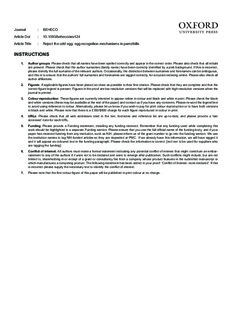| dc.contributor.author | Yang, Canchao | |
| dc.contributor.author | Møller, Anders Pape | |
| dc.contributor.author | Røskaft, Eivin | |
| dc.contributor.author | Moksnes, Arne | |
| dc.contributor.author | Liang, Wei | |
| dc.contributor.author | Stokke, Bård Gunnar | |
| dc.date.accessioned | 2017-10-25T13:21:29Z | |
| dc.date.available | 2017-10-25T13:21:29Z | |
| dc.date.created | 2014-06-10T07:54:04Z | |
| dc.date.issued | 2014 | |
| dc.identifier.citation | Behavioral Ecology. 2014, 25 (6), 1320-1324. | nb_NO |
| dc.identifier.issn | 1045-2249 | |
| dc.identifier.uri | http://hdl.handle.net/11250/2462158 | |
| dc.description.abstract | Studies of the behavior of animals when confronted with tasks differing in complexity can improve our understanding of animal cognition and learning mechanisms. Coevolutionary interactions between brood parasites and their hosts provide an ideal opportunity for studying animal cognition because egg recognition and rejection are some of the most important adaptations evolved in hosts to counter brood parasitism. The cognitive mechanisms hosts employ in egg recognition have received substantial interest, with 2 main hypotheses being put forward: 1) true egg recognition based on a knowledge of the hosts’ own egg appearance (template that is innate and/or learned) and 2) discordancy by which individuals simply recognize eggs that are in minority as parasitic. These hypotheses are not necessarily mutually exclusive. We conducted egg experiments in the ashy-throated parrotbill (Paradoxornis alphonsianus), a common cuckoo (Cuculus canorus) host that lays immaculate, polymorphic eggs, and we obtained support for both hypotheses. Parrotbills use the presence of own eggs as a cue for recognizing parasitic eggs, supporting true recognition, but without the presence of own eggs as a template they failed to recognize the parasitic egg. Furthermore, some individuals erroneously rejected their own eggs when in minority, supporting recognition by discordancy. Such a combination of cognitive mechanisms that involves true recognition and discordancy in egg recognition in a single population has as far as we can tell never previously been described. | nb_NO |
| dc.language.iso | eng | nb_NO |
| dc.publisher | Oxford University Press (OUP) | nb_NO |
| dc.title | Reject the odd egg: Egg recognition mechanisms in parrotbills | nb_NO |
| dc.type | Journal article | nb_NO |
| dc.type | Peer reviewed | nb_NO |
| dc.description.version | acceptedVersion | nb_NO |
| dc.source.pagenumber | 1320-1324 | nb_NO |
| dc.source.volume | 25 | nb_NO |
| dc.source.journal | Behavioral Ecology | nb_NO |
| dc.source.issue | 6 | nb_NO |
| dc.identifier.doi | 10.1093/beheco/aru124 | |
| dc.identifier.cristin | 1137191 | |
| dc.relation.project | Norges forskningsråd: 218144 | nb_NO |
| dc.description.localcode | © The Author 2014. Published by Oxford University Press on behalf of the International Society for Behavioral Ecology. All rights reserved. This is the authors' accepted and refereed manuscript to the article. | nb_NO |
| cristin.unitcode | 194,66,10,0 | |
| cristin.unitname | Institutt for biologi | |
| cristin.ispublished | true | |
| cristin.fulltext | original | |
| cristin.fulltext | postprint | |
| cristin.qualitycode | 2 | |
